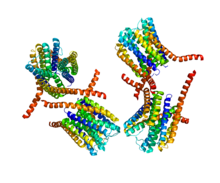MAPEG family
| MAPEG family | |||||||||||
|---|---|---|---|---|---|---|---|---|---|---|---|
 Crystal structure of human leukotriene C4 synthase. [1] | |||||||||||
| Identifiers | |||||||||||
| Symbol | MAPEG | ||||||||||
| Pfam | PF01124 | ||||||||||
| InterPro | IPR001129 | ||||||||||
| PROSITE | PS01297 | ||||||||||
| SCOP2 | 2pno / SCOPe / SUPFAM | ||||||||||
| OPM superfamily | 178 | ||||||||||
| OPM protein | 4yl3 | ||||||||||
| |||||||||||
In molecular biology the MAPEG (Membrane-Associated Proteins in Eicosanoid and Glutathione metabolism) family of proteins are a group of membrane associated proteins with highly divergent functions.[2] Included are the 5-lipoxygenase-activating protein (gene FLAP), leukotriene C4 synthase (EC 2.5.1.37), which catalyzes the production of leukotriene C4 (LTC4) from leukotriene A4 (LTA4), and microsomal glutathione S-transferase II (EC 2.5.1.18) (GST-II), which also produces LTC4 from LTA4.
Another example is prostaglandin E synthase. This enzyme catalyses the synthesis of PGE2 from PGH2 (produced by cyclooxygenase from arachidonic acid). Because of structural similarities in the active sites of FLAP, LTC4 synthase, and PGE synthase, substrates for each enzyme can compete with one another and modulate synthetic activity.
Subfamilies
[edit]Human proteins containing this domain
[edit]References
[edit]- ^ Ago H, Kanaoka Y, Irikura D, Lam BK, Shimamura T, Austen KF, Miyano M (August 2007). "Crystal structure of a human membrane protein involved in cysteinyl leukotriene biosynthesis". Nature. 448 (7153): 609–12. Bibcode:2007Natur.448..609A. doi:10.1038/nature05936. PMID 17632548. S2CID 4324979.
- ^ Jakobsson PJ, Morgenstern R, Mancini J, Ford-Hutchinson A, Persson B (March 1999). "Common structural features of MAPEG -- a widespread superfamily of membrane associated proteins with highly divergent functions in eicosanoid and glutathione metabolism". Protein Science. 8 (3): 689–92. doi:10.1110/ps.8.3.689. PMC 2144274. PMID 10091672.
